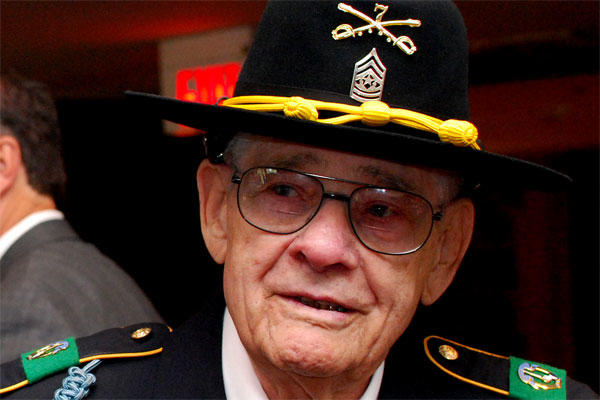U.S. Army awards officials have decided not to amend the military records of Command Sgt. Maj. Basil Plumley, despite discrepancies in the late hero's records that cast doubt on the medals that made him a battlefield legend.
Army Human Resources Command's review of Plumley's records was prompted when military researcher Brian Siddall alleged that Plumley wore unauthorized combat and valor awards that exaggerated wartime achievements and elevated his status in the airborne and infantry communities.
Plumley, who died from cancer on Oct. 10, 2012 at the age of 92, was a major figure in the 1992 book, "We Were Soldiers Once ... and Young," co-authored by Joseph L. Galloway and retired Lt. Gen. Harold G. Moore.
The book was a moving account of the November 1965 Battle of Ia Drang Valley in the Vietnam War and the heroic fight that 450 soldiers of 1st Battalion, 7th Cavalry, put up against a superior force of 2,000 North Vietnamese soldiers at LZ X-Ray.
The best-selling book and the Hollywood movie elevated Plumley to celebrity status long after his retirement from the Army in 1974.
Siddall, an independent researcher whose father and uncle served during World War II -- the latter as a paratrooper who was killed during the D-Day invasion of Europe -- leveled the allegations against Plumley after an extensive study of his service records.
His research into Plumley's famed exploits in the 82nd Airborne Division during World War II later prompted him to write two online articles in 2015 that show discrepancies between Plumley's service records and the awards and actions for which he took credit.
According to Siddall, who obtained Plumley's service records, Plumley inflated his heroism in battle by claiming valor awards, Combat Infantry Badge stars and combat jump stars that he never earned.
Siddall's request to have Plumley's headstone at Fort Benning, Georgia, corrected prompted the review by Army Human Resources Command.
"Based on the facts available, U.S. Army Human Resources Command has determined there is no substantial evidence that any of CSM (R) Basil Plumley's awards or decorations are in error," wrote Lt. Col. Janet Herrick, a spokeswoman for HRC. "Absent this evidence, U.S. Army Human Resources Command is not authorized to alter or amend CSM (R) Plumley's military records."
Unless there is a change is made to the DD 214, or separation of service form, Fort Benning has no authority to change or alter the current headstone, according to Herrick.
"Any petition to change CSM (R) Plumley's DD 214 due to error should be addressed to the Army Board of Corrections for Military Records (ABCMR) along with supporting evidence of error."
In an email to Military.com, Siddall accused the command of a "cover up" and compared the case of Plumley to that of Pat Tillman, the professional football player who after the Sept. 11, 2001, terrorist attacks left a lucrative career in the NFL to become an Army Ranger. He was killed by friendly fire in Afghanistan in 2004.
"This is nothing but a cover up," Siddall wrote. "No different than when the Army lied about the death of Pat Tillman. They tried to cover up the fact that Tillman's own platoon killed him."
Siddall voiced his frustration with HRC's recommendation that the Army Board of Corrections for Military Records has to be contacted for any records changes.
"The only person who can petition the ABCM is either the Veteran themselves or, if dead, a family member," he said. No one else can contact them about this issue. … The Army is trying to allow a fraud like Plumley to keep awards on a headstone he didn't earn."
Herrick told Military.com "a record can be misplaced and not make it into a service member's records. I can't explain for whatever reason why -- there are countless reasons why -- but at the time when he was discharged the DD 214 had those records."
Herrick did acknowledge that "there are discrepancies" in Plumley's military records, but said HRC does not have the authority to amend them.
According to Plumley's records, he exaggerated the number of Combat Infantry Badge awards he was authorized, Siddall maintains. The CIB is a sacred award bestowed only upon infantrymen for engaging in direct combat with the enemy.
Plumley wore a Combat Infantry Badge with two stars -- which means three CIB awards -- one for World War II, one for the Korean War and one for the Vietnam War, Siddall maintains. As an artillery scout, Plumley didn't meet the criteria for World War II and he never served in the Korean War, so his first and only CIB was for his service in Vietnam, Siddall said.
In "We Were Soldiers Once … and Young," Plumley is described as "a two war man and wore master parachutist wings with five combat-jump stars," referring to Plumley's service in World War II and the Korean War.
"Plumley had survived all four combat jumps of the 82nd Airborne Division in World War II: Sicily and Salerno in 1943, and then in 1944, D day at Normandy, and Market-Garden in the Netherlands," according to the book. "For that matter, he also made one combat parachute jump in the Korean War, with the 187th Airborne Infantry Regiment."
In the 2002 Hollywood movie "We Were Soldiers," actor Mel Gibson, playing then Lt. Col. Moore, gave a similar description of Plumley, who was played by actor Sam Elliott.
Siddall argues Plumley's records show that he served in the 320th Glider Field Artillery Battalion as a scout. Plumley was Glider, meaning he was an 82nd Airborne Division gliderman, not an 82nd Airborne Division paratrooper, Siddall writes.
Plumley's military records place him in units that did not serve in the Korean War, Siddall writes, so he could not have made a combat jump with the 187th.
Plumley also wore valor awards he did not earn, Siddall wrote. Plumley wore a Silver Star with a bronze oak leaf cluster, which indicates a second Silver Star.
Among the many documents Siddall provides in his research is an Oct. 2, 2015, letter from Army Lt. Col Wil Neubauer, chief of the Awards and Decorations Branch. The letter states Plumley was authorized only one Silver Star and the Bronze Star with one oak leaf cluster, not two. The letter also states that Plumley was not authorized to wear the V device with his Bronze Star medals.
Siddall sent his findings to Fort Benning in late 2015 and asked if the information on Plumley's headstone -- "Silver Star with OLC" and "BSM W/V 2nd OLC" -- was going to be corrected.
"The Army is trying to protect a fraud," he wrote in his July 21 email to Military.com. "Ft. Benning is a place where honor used to matter but not now. To allow a known liar like Plumley buried next to Hero's [sic] is frightening indeed."
-- Matthew Cox can be reached at matthew.cox@military.com.






























